Comparison of Liquid Water Dynamics in Bent Gas Channels of a Polymer Electrolyte Membrane Fuel Cell with Different Channel Cross Sections in a Channel Flooding Situation
Abstract
:1. Introduction
2. Model Formulation
2.1. Computational Domain
2.2. Numerical Method
2.3. Boundary and Operating Conditions
3. Results and Discussion
3.1. Effect of Surface Contact Angle of Top and Side Walls
3.2. Effect of GDL Surface Contact Angle and Air Inlet Velocity
4. Conclusions
- Considering both of the WVF and the WCR for the GDL surface, the trapezoidal channel with open angles of 60° provides the most favorable performance in a channel flooding situation. While changing the top and side wall contact angles from 45° to 120°, the hydrophobic contact angle of 120° shows the best results.
- Among the three GDL contact angles of 90°, 110°, and 140°, the hydrophobic GDL contact angle of 140° provides the most favorable water removal characteristics in a channel flooding situation.
- For all the three channel cross-sectional shapes, the water removal rate increases and the liquid water interface shows more complex patterns as the air inlet velocity increases.
Acknowledgments
Author Contributions
Conflicts of Interest
References
- Wang, C.; Wang, S.; Peng, L.; Zhang, J.; Shao, Z.; Huang, J.; Sun, C.; Ouyang, M.; He, X. Recent progress on the key materials and components for proton exchange membrane fuel cells in vehicle applications. Energies 2016, 9, 603–641. [Google Scholar] [CrossRef]
- Anderson, R.; Zhang, L.; Ding, Y.; Blanco, M.; Bi, X.; Wilkinson, D.P. A critical review of two-phase flow in gas flow channels of proton exchange membrane fuel cells. J. Power Sources 2010, 195, 4531–4553. [Google Scholar] [CrossRef]
- Vinh, N.D.; Kim, H.-M. Comparison of numerical and experimental studies for flow-field optimization based on under-rib convection in polymer electrolyte membrane fuel cells. Energies 2016, 9, 844–860. [Google Scholar] [CrossRef]
- Liu, X.; Guo, H.; Ye, F.; Ma, C.F. Water flooding and pressure drop characteristics in flow channels of proton exchange membrane fuel cells. Electrochim. Acta 2007, 52, 3607–3614. [Google Scholar] [CrossRef]
- Grimm, M.; See, E.J.; Kandlikar, S.G. Modeling gas flow in PEMFC channels: Part I—Flow pattern transitions and pressure drop in a simulated ex situ channel with uniform water injection through the GDL. Int. J. Hydrog. Energy 2012, 37, 12489–12503. [Google Scholar] [CrossRef]
- Wan, Z.; Chang, H.; Shu, S.; Wang, Y.; Tang, H. A review on cold start of proton exchange membrane fuel cells. Energies 2014, 7, 3179–3203. [Google Scholar] [CrossRef]
- Ferreira, R.B.; Falcão, D.S.; Oliveira, V.B.; Pinto, A.M.F.R. Numerical simulations of two-phase flow in proton exchange membrane fuel cells using the volume of fluid method: A review. J. Power Sources 2015, 277, 329–342. [Google Scholar] [CrossRef]
- Owejan, J.P.; Trabold, T.A.; Jacobson, D.L.; Arif, M.; Kandlikar, S.G. Effects of flow field and diffusion layer properties on water accumulation in a PEM fuel cell. Int. J. Hydrog. Energy 2007, 32, 4489–4502. [Google Scholar] [CrossRef]
- Zhu, X.; Liao, Q.; Sui, P.C.; Djilali, N. Numerical investigation of water droplet dynamics in a low-temperature fuel cell microchannel: Effect of channel geometry. J. Power Sources 2010, 195, 801–812. [Google Scholar] [CrossRef]
- Manso, A.P.; Marzo, F.F.; Barranco, J.; Garikano, X.; Mujika, M.G. Influence of geometric parameters of the flow fields on the performance of a PEM fuel cell. A review. Int. J. Hydrog. Energy 2012, 37, 15256–15287. [Google Scholar] [CrossRef]
- Rath, C.D.; Kandlikar, S.G. Liquid filling in a corner with a fibrous wall—An application to two-phase flow in PEM fuel cell gas channels. Colloid Surf. A 2011, 384, 653–660. [Google Scholar] [CrossRef]
- Lu, Z.; Rath, C.; Zhang, G.; Kandlikar, S.G. Water management studies in PEM fuel cells, Part IV: Effects of channel surface wettability, geometry and orientation on the two-phase flow in parallel gas channels. Int. J. Hydrog. Energy 2011, 36, 9864–9875. [Google Scholar] [CrossRef]
- Gopalan, P.; Kandlikar, S.G. Effect of channel materials and trapezoidal corner angles on emerging droplet behavior in proton exchange membrane fuel cell gas channels. J. Power Sources 2014, 248, 230–238. [Google Scholar] [CrossRef]
- Shah, M.M.; Kandlikar, S.G. Water emergence from the land region and water-sidewall interactions in proton exchange membrane fuel cell gas channels with microgrooves. J. Power Sources 2015, 297, 127–139. [Google Scholar] [CrossRef]
- Concus, P.; Finn, R. Capillary surfaces in a wedge differing contact angles. Microgravity Sci. Technol. 1994, 7, 152–155. [Google Scholar]
- Turhan, A.; Kim, S.; Hatzell, M.; Mench, M.M. Impact of channel wall hydrophobicity on through-plane water distribution and flooding behavior in a polymer electrolyte fuel cell. Electrochim. Acta 2010, 55, 2734–2745. [Google Scholar] [CrossRef]
- Ding, Y.; Bi, H.T.; Wilkinson, D.P. Three-dimensional numerical simulation of water droplet emerging from a gas diffusion layer surface in micro-channels. J. Power Sources 2010, 195, 7278–7288. [Google Scholar] [CrossRef]
- Lorenzini-Gutierrez, D.; Kandlikar, S.G.; Hernandez-Guerrero, A.; Elizalde-Blancas, F. Residence time of water film and slug flow features in fuel cell gas channels and their effect on instantaneous area coverage ratio. J. Power Sources 2015, 279, 567–580. [Google Scholar] [CrossRef]
- Jo, J.H.; Kim, W.T. Numerical simulation of water droplet dynamics in a right angle gas channel of a polymer electrolyte membrane fuel cell. Int. J. Hydrog. Energy 2015, 40, 8368–8383. [Google Scholar] [CrossRef]
- Flipo, G.; Josset, C.; Bellettre, J.; Auvity, B. Clarification of the surface wettability effects on two-phase flow patterns in PEMFC gas channels. Int. J. Hydrog. Energy 2016, 41, 15518–15527. [Google Scholar] [CrossRef]
- Owejan, J.P.; Gagliardo, J.J.; Sergi, J.M.; Kandlikar, S.G.; Trabold, T.A. Water management studies in PEM fuel cells, Part I: Fuel cell design and in situ water distributions. Int. J. Hydrog. Energy 2009, 34, 3436–3444. [Google Scholar] [CrossRef]
- ANSYS Inc. Ansys Fluent Theory Guide Release 14.0; ANSYS Inc.: Canonsburg, PA, USA, 2011. [Google Scholar]
- Brackbill, J.U.; Kothe, D.B.; Zamach, C. A continuum method for modeling surface tension. J. Comput. Phys. 1992, 100, 335–354. [Google Scholar] [CrossRef]
- Youngs, D.L. Time-dependent multi-material flow with large fluid distortion. In Numerical Methods for Fluid Dynamics; Morton, K.W., Baines, M.J., Eds.; Academic Press: New York, NY, USA, 1982. [Google Scholar]
- Park, S.; Lee, J.-W.; Popov, B.N. A review of gas diffusion layer in PEM fuel cells: Materials and designs. Int. J. Hydrog. Energy 2012, 37, 5850–5865. [Google Scholar] [CrossRef]
- Gurau, V.; Bluemle, M.J.; De Castro, E.S.; Tsou, Y.-M.; Adin Mann, J., Jr.; Zawodzinski, T.A., Jr. Characterization of transport properties in gas diffusion layers for proton exchange membrane fuel cells 1. Wettability (internal contact angle to water and surface energy of GDL fibers). J. Power Sources 2006, 160, 1156–1162. [Google Scholar] [CrossRef]
- Pekula, N.; Heller, K.; Chuang, P.A.; Turhan, A.; Mench, M.M.; Brenizer, J.S.; Ünlü, K. Study of water distribution and transport in a polymer electrolyte fuel cell using neutron imaging. Nucl. Instrum. Meth. A 2005, 542, 134–141. [Google Scholar] [CrossRef]
- Trabold, T.A.; Owejan, J.P.; Jacobson, D.L.; Arif, M.; Huffman, P.R. In situ investigation of water transport in an operating PEM fuel cell neutron radiography: Part 1—Experimental method and serpentine flow field results. Int. J. Heat Mass Transf. 2006, 49, 4712–4720. [Google Scholar] [CrossRef]
- Le, A.D.; Zhou, B.; Shiu, H.-R.; Lee, C.-I.; Chang, W.-C. Numerical simulation and experimental validation of liquid water behaviors in a proton exchange membrane fuel cell cathode with serpentine channels. J. Power Sources 2010, 195, 7302–7315. [Google Scholar] [CrossRef]
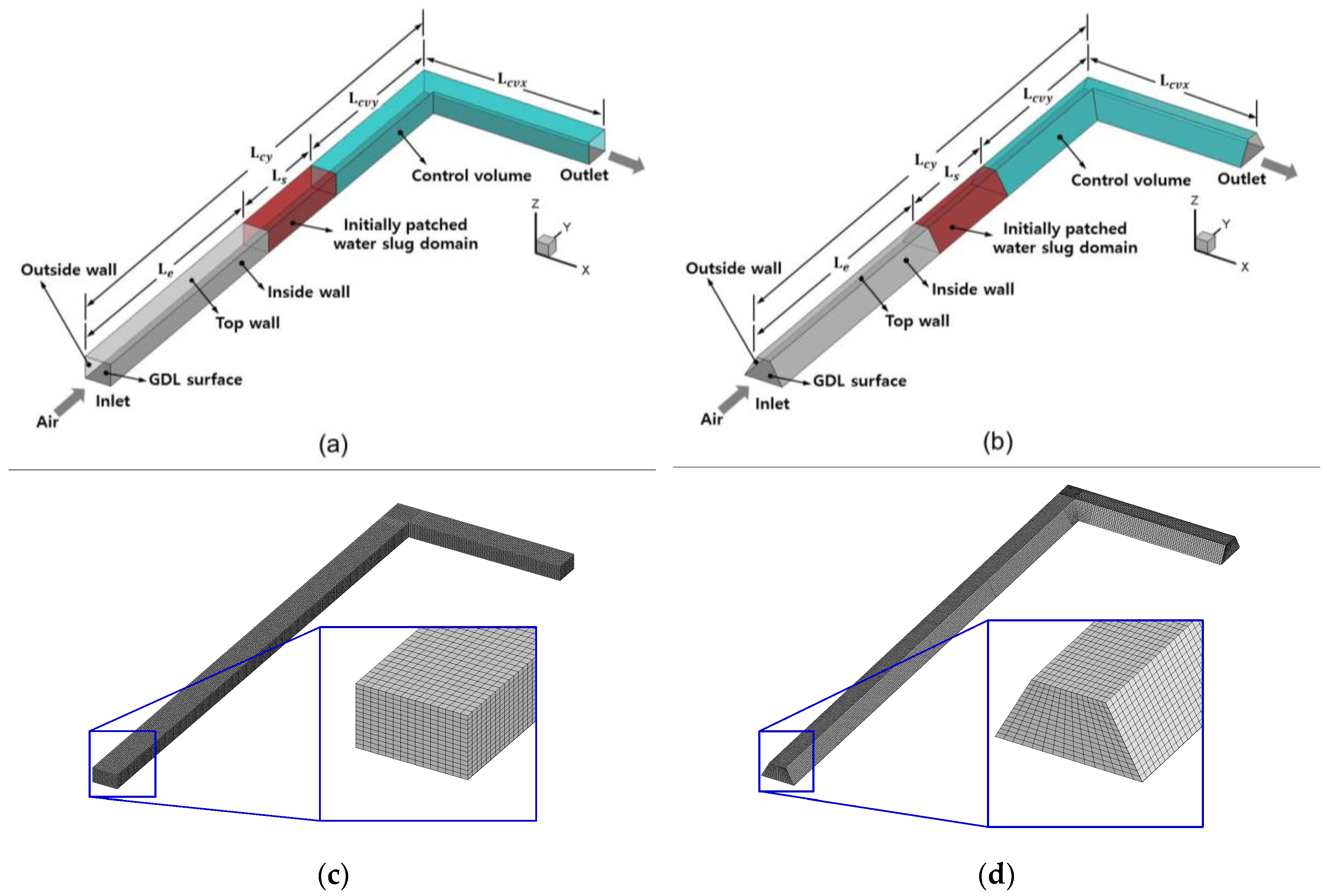
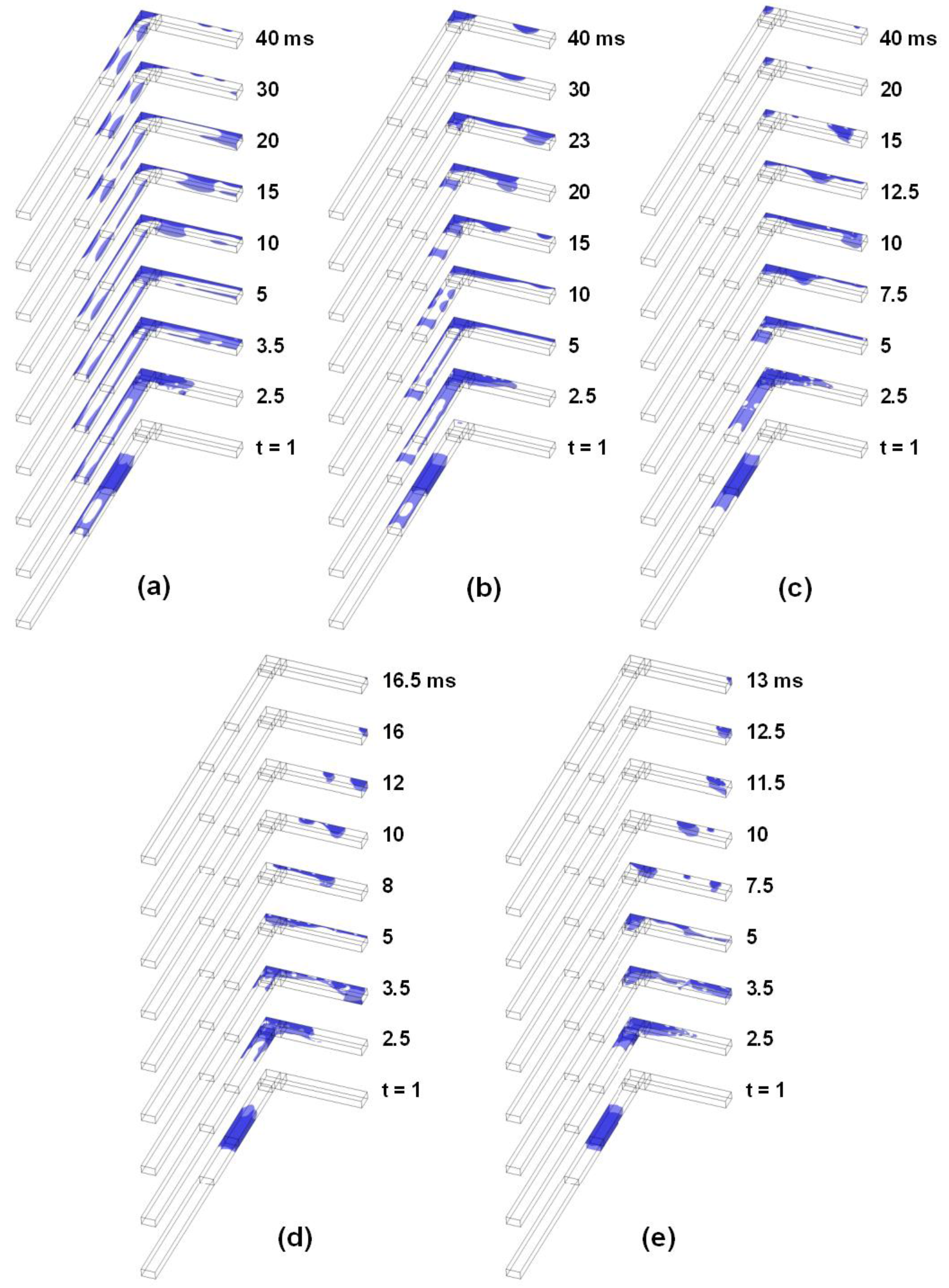
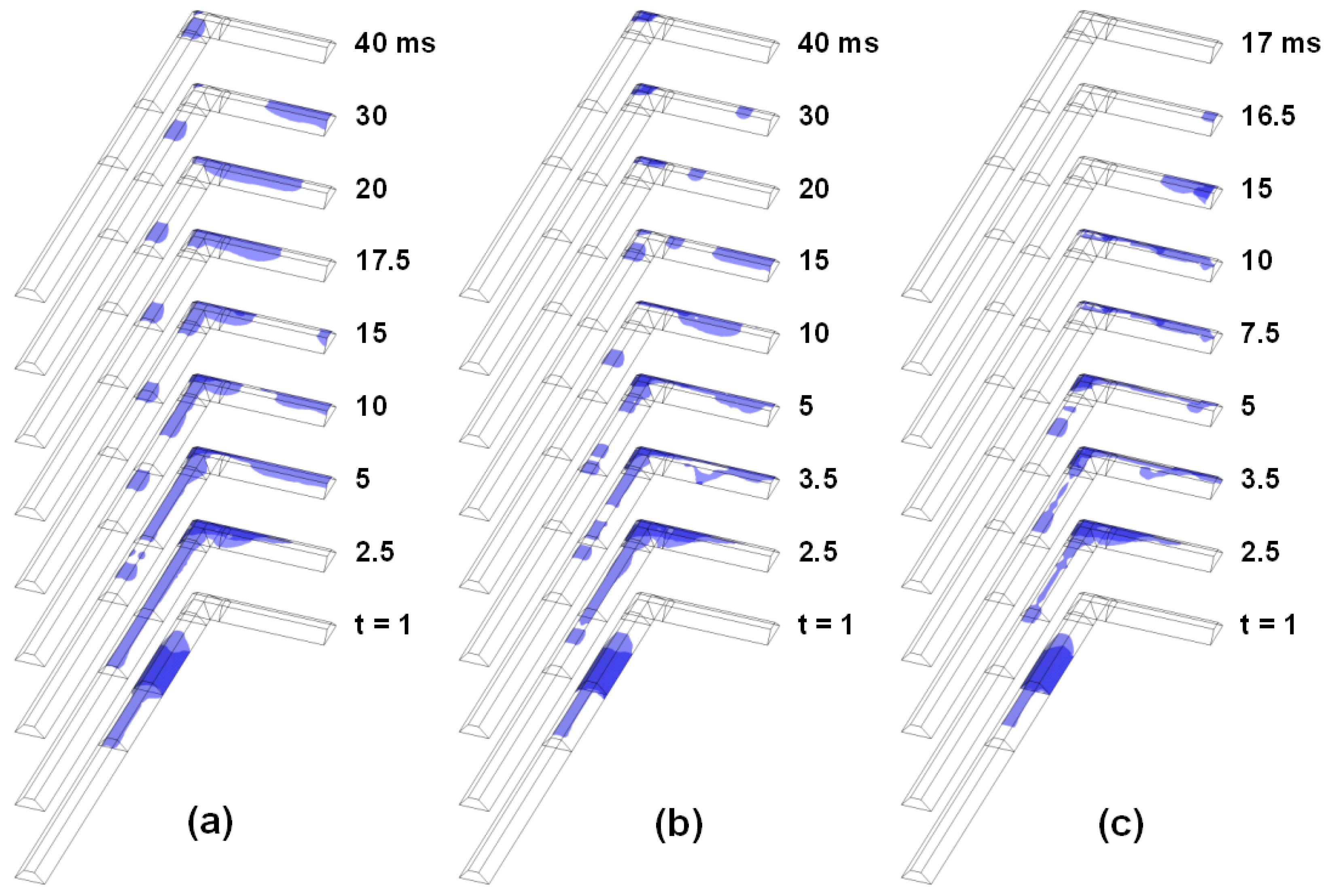
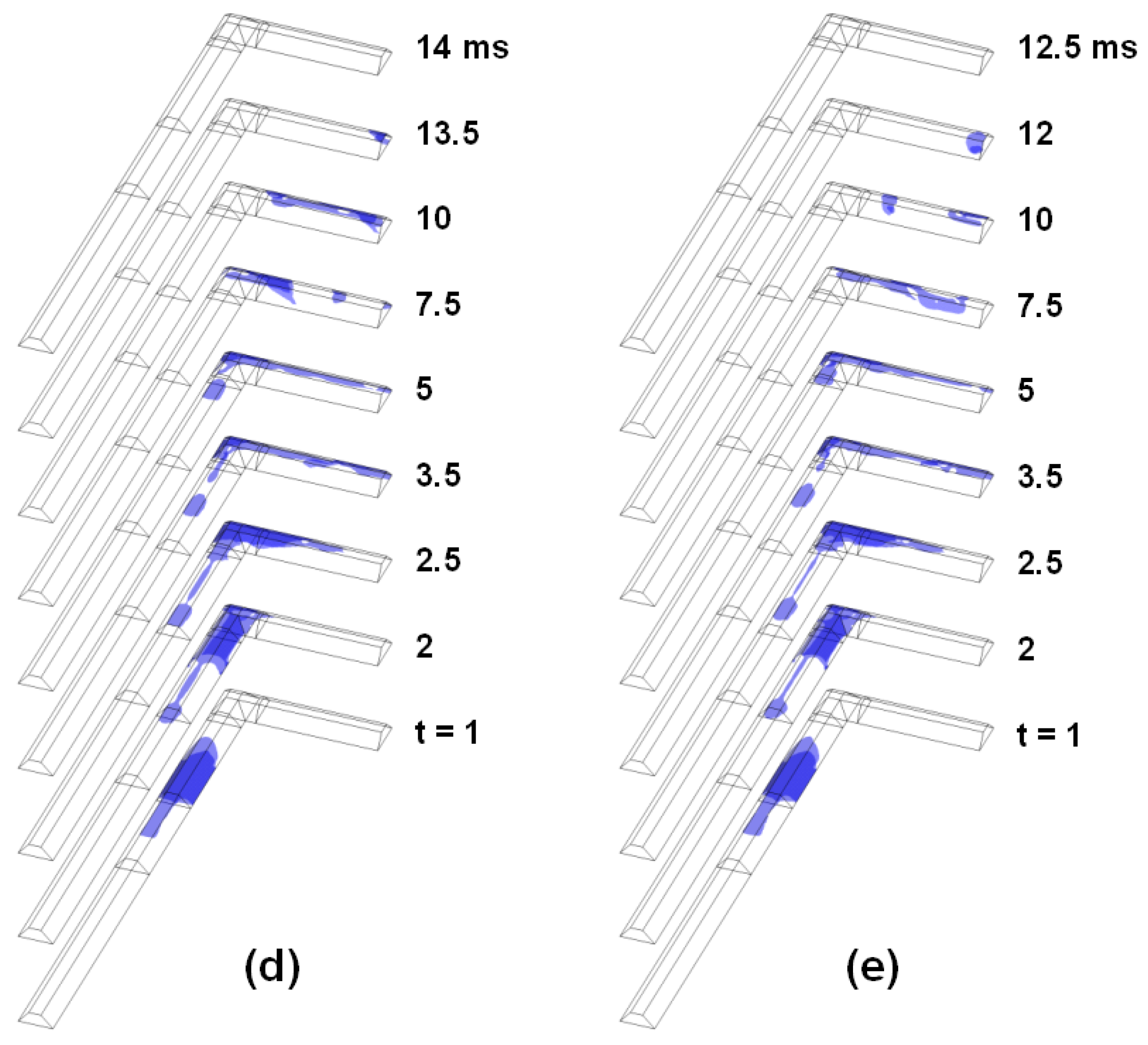
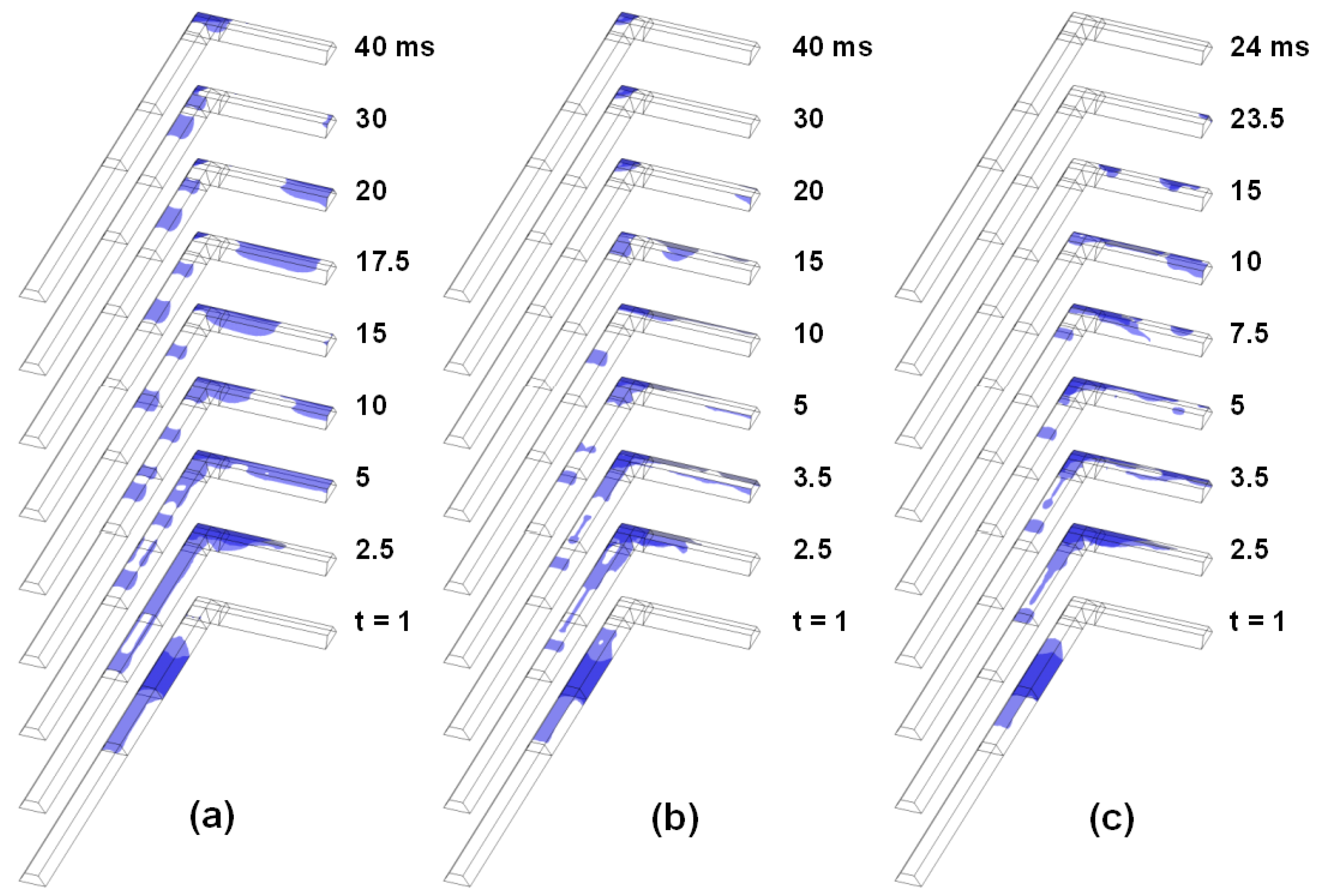
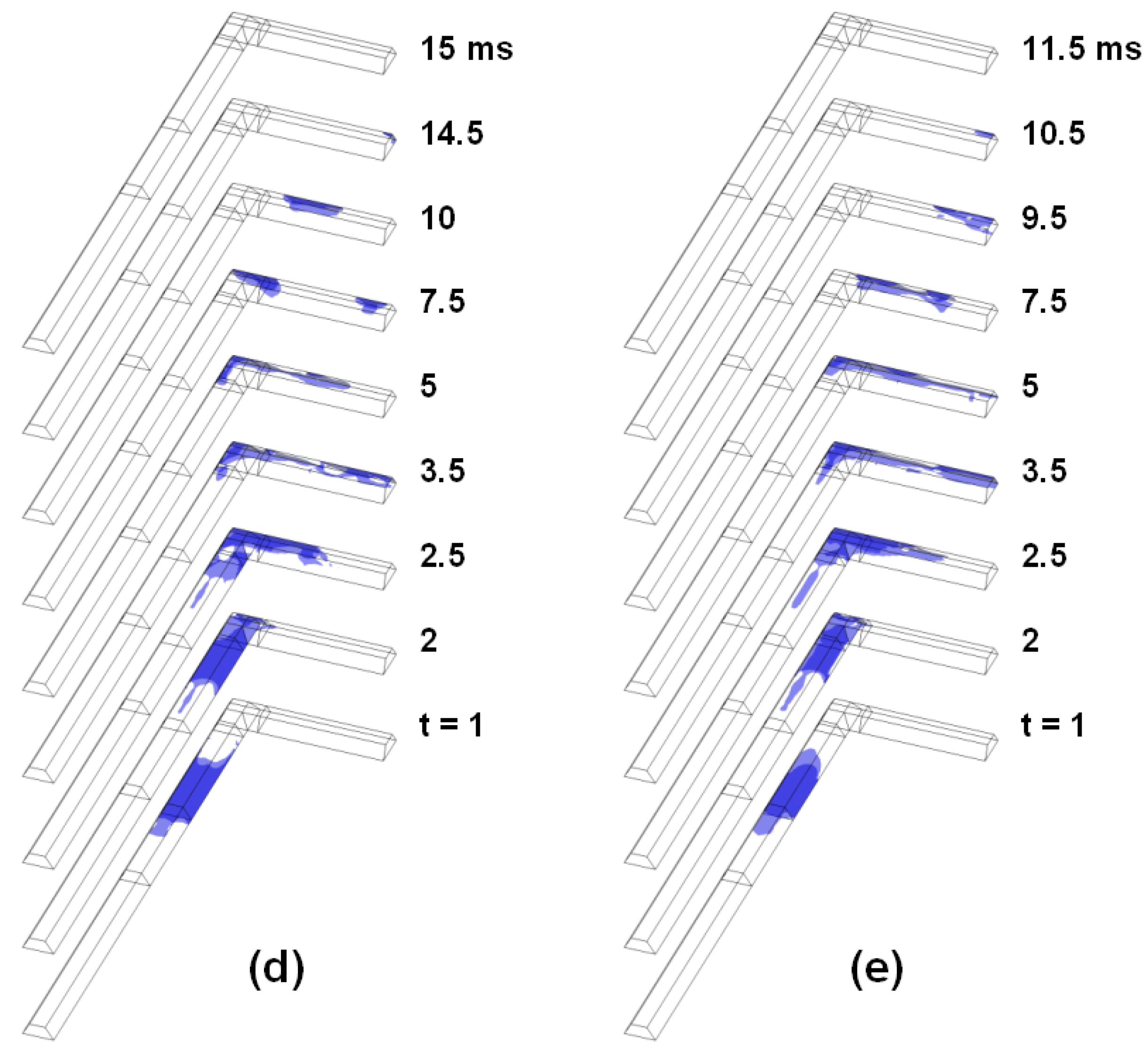
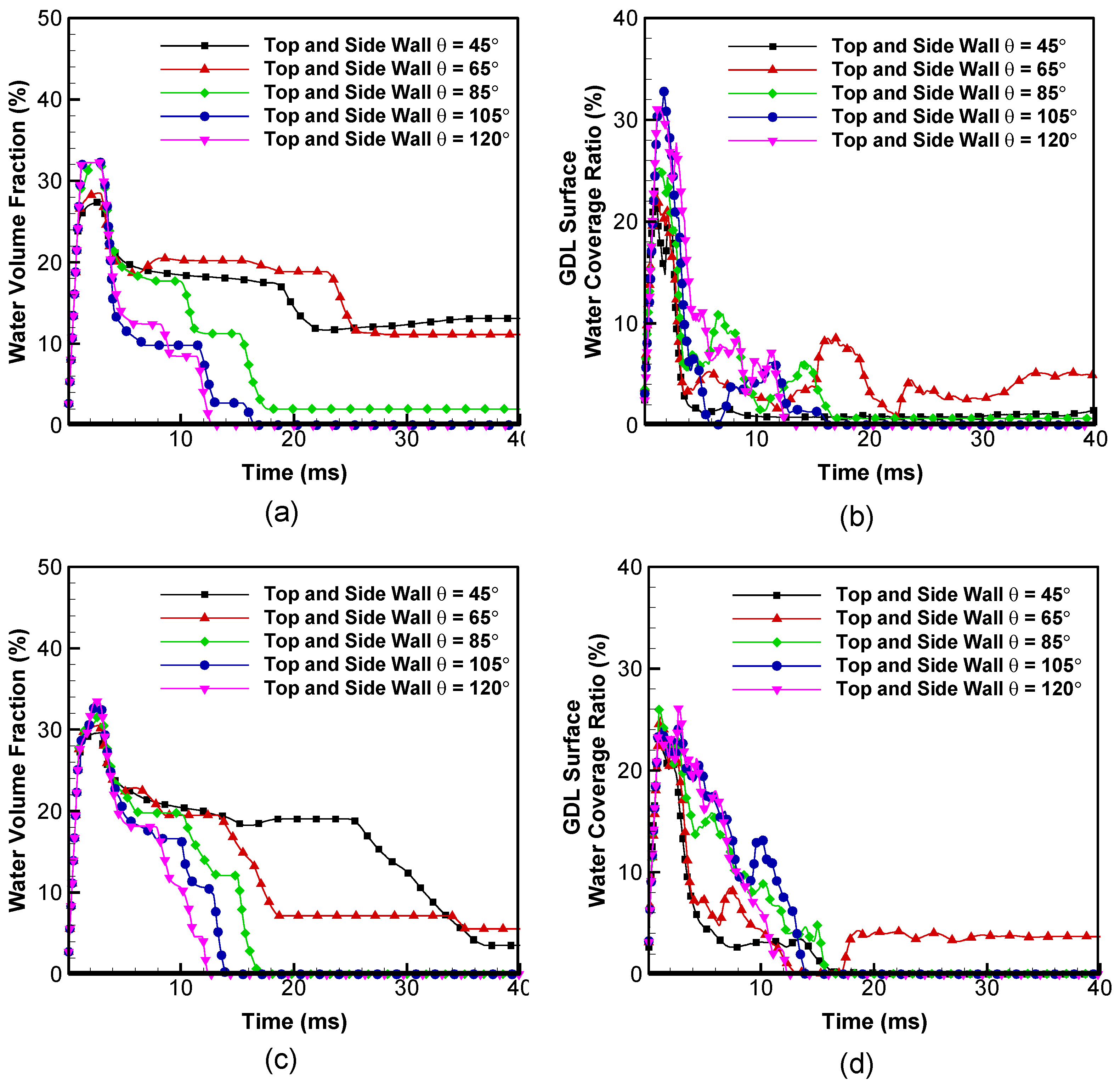
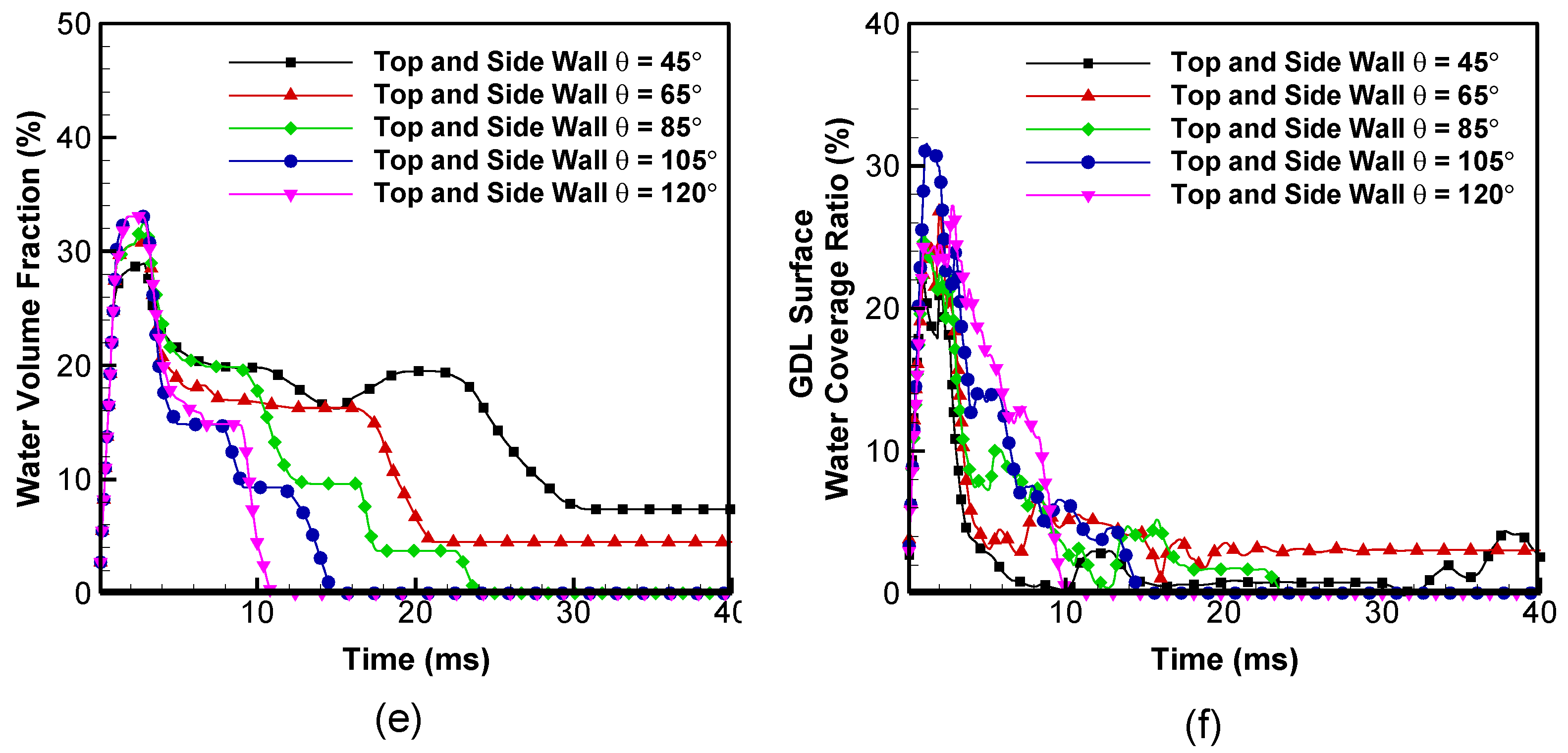
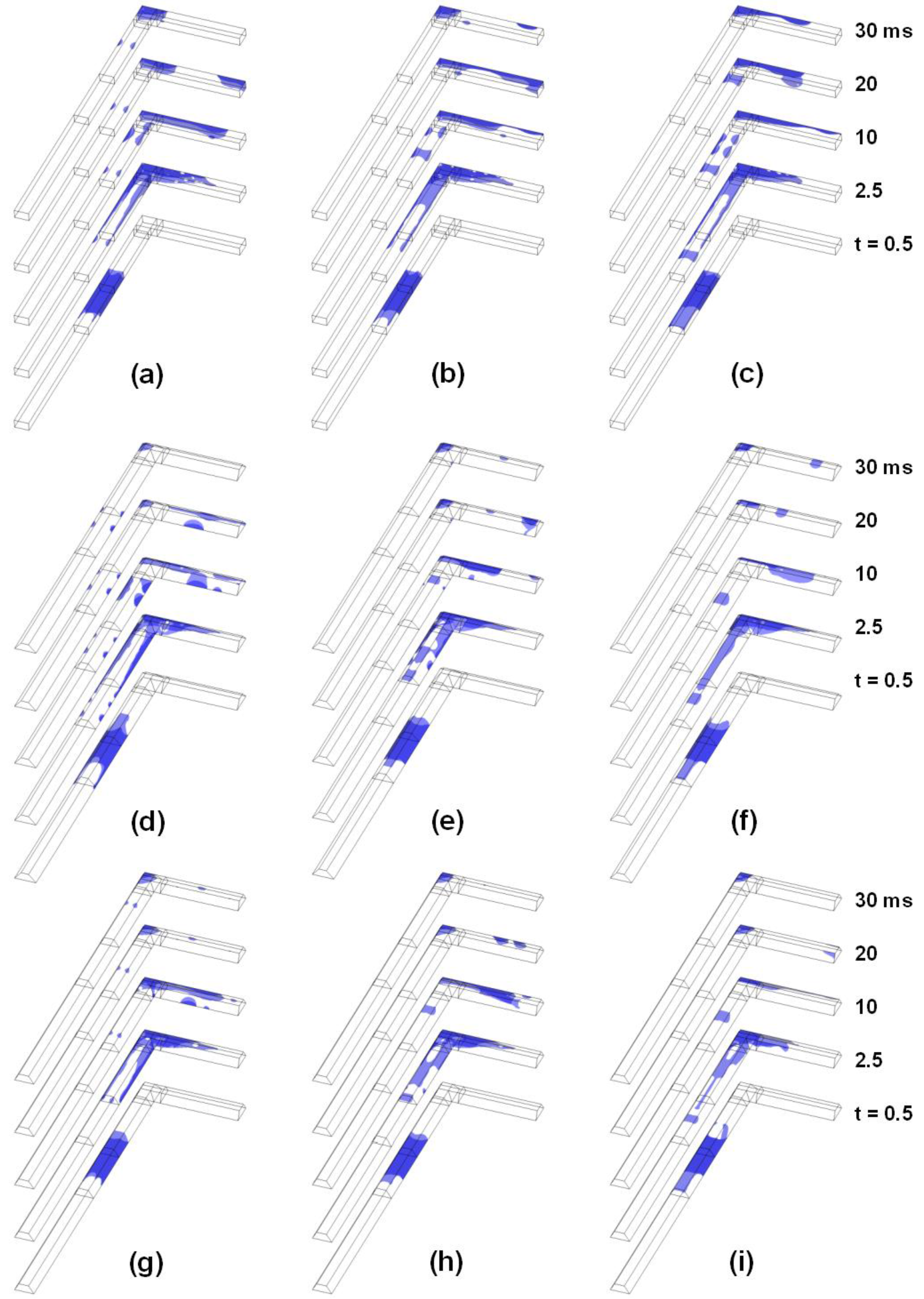
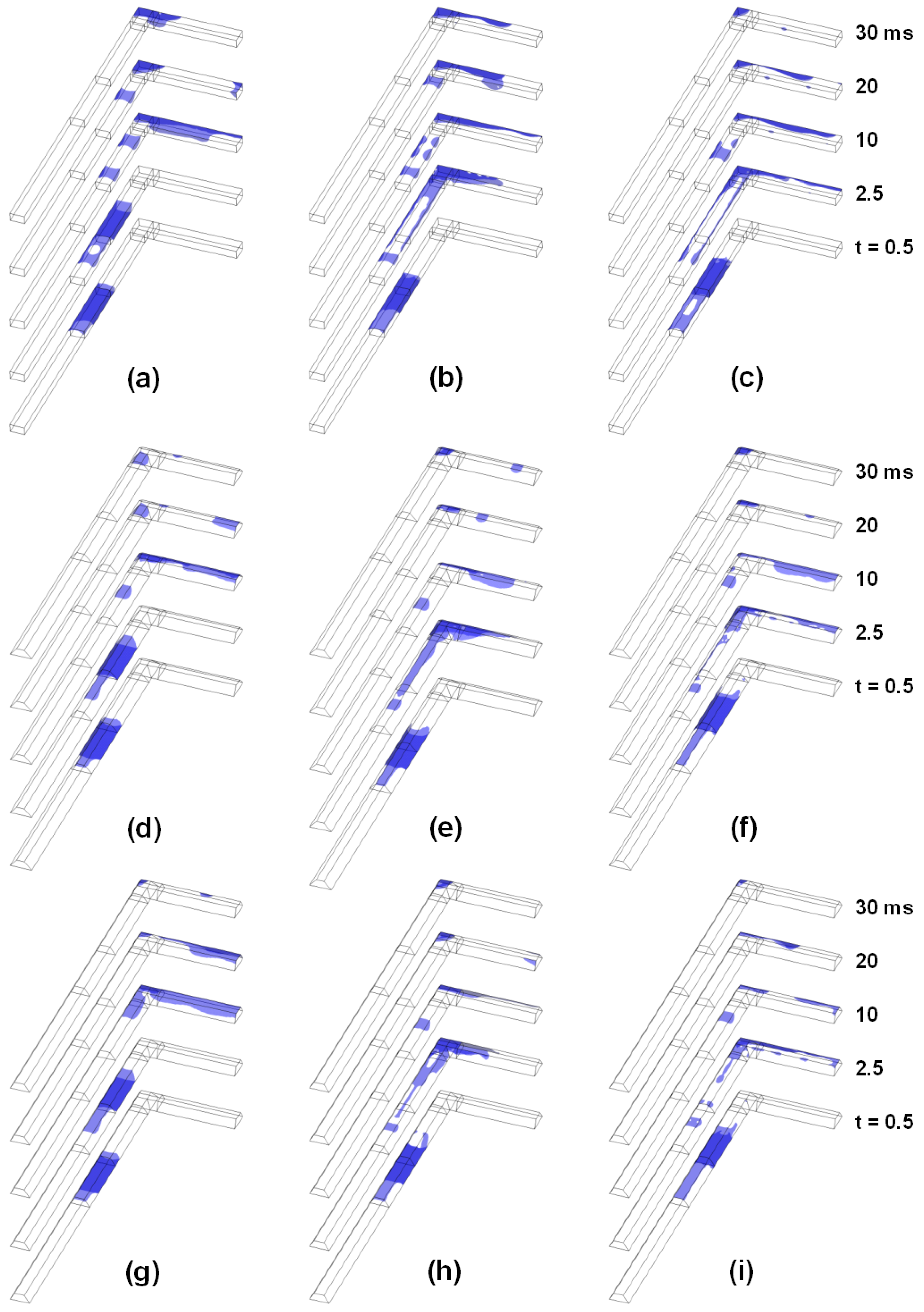
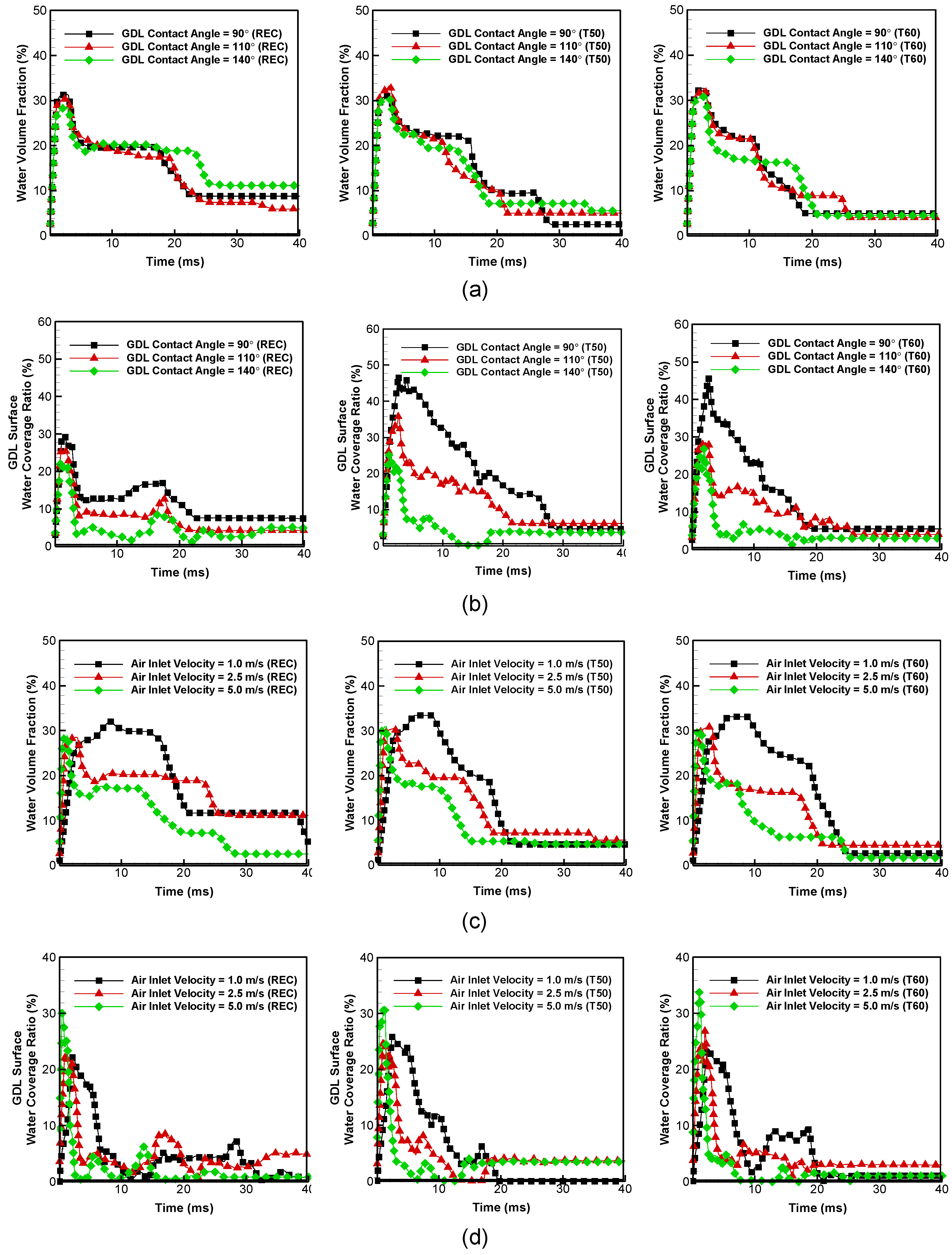
© 2017 by the authors. Licensee MDPI, Basel, Switzerland. This article is an open access article distributed under the terms and conditions of the Creative Commons Attribution (CC BY) license (http://creativecommons.org/licenses/by/4.0/).
Share and Cite
Kim, J.H.; Lee, G.G.; Kim, W.T. Comparison of Liquid Water Dynamics in Bent Gas Channels of a Polymer Electrolyte Membrane Fuel Cell with Different Channel Cross Sections in a Channel Flooding Situation. Energies 2017, 10, 748. https://doi.org/10.3390/en10060748
Kim JH, Lee GG, Kim WT. Comparison of Liquid Water Dynamics in Bent Gas Channels of a Polymer Electrolyte Membrane Fuel Cell with Different Channel Cross Sections in a Channel Flooding Situation. Energies. 2017; 10(6):748. https://doi.org/10.3390/en10060748
Chicago/Turabian StyleKim, Jin Hyun, Gwang Goo Lee, and Woo Tae Kim. 2017. "Comparison of Liquid Water Dynamics in Bent Gas Channels of a Polymer Electrolyte Membrane Fuel Cell with Different Channel Cross Sections in a Channel Flooding Situation" Energies 10, no. 6: 748. https://doi.org/10.3390/en10060748
APA StyleKim, J. H., Lee, G. G., & Kim, W. T. (2017). Comparison of Liquid Water Dynamics in Bent Gas Channels of a Polymer Electrolyte Membrane Fuel Cell with Different Channel Cross Sections in a Channel Flooding Situation. Energies, 10(6), 748. https://doi.org/10.3390/en10060748





